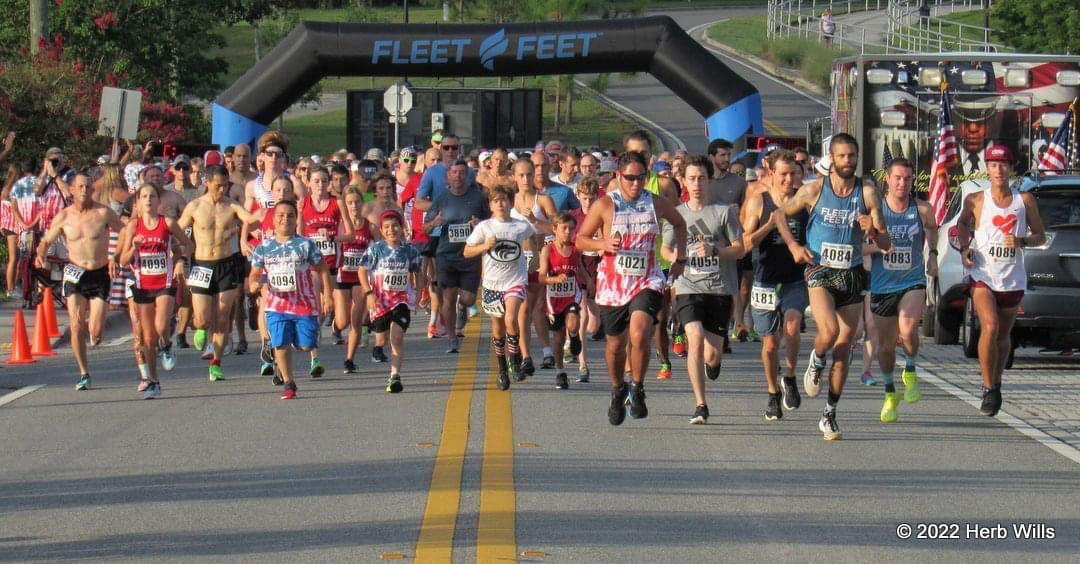Blasting past Firecracker 5K: Hot summer running days are here again | Yon

We have survived a month of running in summer weather. I do recognize that the first day of summer on the astronomical calendar is June 21, but summer weather rolled into Tallahassee on or before June 1 on the meteorological calendar.
Regardless of which calendar we use it is here to stay for a long time.
Diet: Eating smarter, living longer: Diet can boost health, longevity | Mahoney
Groceries: Find your frugal sweet spot: Five money-saving tips for grocery shoppers
Swimming: Swim Tallahassee: Things going swimmingly at city pools with lifeguard shortages abated
June was punishing with its hot days and limited rain – three days had highs above 100 degrees, and 12 days where high temperatures were from 95 to 99. Only one day in June did not reach 90 degrees; The high for that day, June 6, was 88 degrees.
The good news is that mornings have offered some refuge and a time to acclimate. The first five days of June saw temperatures drop below 70 degrees (66 was the coolest) during the early mornings.
There were 27 days during which the average temperatures for the day were higher than the longtime average, two days when it was right on average and only one day National Weather Service Web Climatological Data for Tallahassee Area, June 2022.
Firecracker 5K winners
However, when the Fourth of July arrives, everyone agrees summer is in full swing. Just ask any of the approximately 324 runners lined up for the start of the Firecracker 5K at 8 a.m. last Monday morning.
The mile runners and walkers got the earlier, cooler start at 7:30 a.m. Conditions seemed as challenging as one would expect for July — high temperature, sunshine, high dew point and high humidity.
Despite its placement in the hottest part of the summer, July 4th remains a very popular day for races.
Matt Mizereck was prepared for the conditions, better than anyone else at least, and won the race in a time of 17:04. Chris O’Kelley fought to catch up but didn’t get to the finish until 17:25. Montford track and field and cross-country coach, Brad Busboom, rounded out the top 3 in 18:20.
On the women’s side, Sheryl Rosen took the top spot in 19:31 and Brittney Barnes was second in 20:47. Red Hills power house Annabelle Wiktorski was next in 21:14. Not bad for a 13-year-old.
Core temps set off brain alarm
Some runners perform better than others when the heat is cranked up. Running in the heat is all about maintaining core body temperature as low as possible. One theory, backed by some good data, holds the brain effectively shuts the body down when the core temperature reaches 104-105 degrees.
It is not that you can’t go on, it is that your brain won’t let you unless you can fix the core temperature problem. Scotty, shut the engines down now or the ship engine is going to blow.
The brain has run the formula and virtually no amount of will power can keep the ship at full power. So don’t be too hard on yourself when you are unable to run your best on summer days.
Alex Hutchinson described one study in his book "Endure."
“Seven experienced cyclists completed a series of rides to exhaustion in hot humid conditions. Exhaustion was defined as ‘unable to sustain a minimum cadence of 50 strokes per minute.’ Before each ride they spent 30 minutes soaking up to the neck in cool, neutral, or warm water for 30 minutes (not really an option in Cascades Park).
This set their starting core temperatures to 97, 99 or 101 degrees. Not surprisingly, the riders with the lowest temperatures to start lasted the longest, doubling the time for the warmest riders. However, all reached exhaustion at 104 degrees. Hutchinson wrote: “It was as if, in crossing that critical threshold, a temperature sensitive circuit breaker had been tripped.”
Fighting heat and humidity
Nothing drives that core temperature up faster than a hot muggy day outside and a dehydrated runner. Runners must protect themselves from the heat if they want to perform.
For runners, dehydration, heat exhaustion and heat stroke are the enemy. They can severely impact performance, knock a runner out of a race, and even be deadly.
Dehydration occurs when you use or lose more fluid than you take in, and your body doesn't have enough water and other fluids to carry out its normal functions. When a body is dehydrated it loses some of its heat fighting tools.
You can usually reverse mild to moderate dehydration by drinking more fluids, but severe dehydration needs immediate medical treatment. Hot weather races, at least, should have medical personnel onsite.
Dehydration and heat stroke
Things to look for to identify dehydration: extreme thirst, less frequent urination, dark-colored urine, fatigue, dizziness, confusion, and unconsciousness.
Heat stroke is a condition caused by your body overheating, usually as a result of prolonged exposure to or physical exertion in high temperatures. This most serious form of heat injury, heat stroke, can occur if your body temperature rises above 104 degrees or higher.
Heat stroke requires emergency treatment. Untreated heat stroke can quickly damage your brain, heart, kidneys, and muscles. It was good to see medical personnel onsite for the Firecracker 5K race.
Thanks again to the Capital City Kiwanis and all the other volunteers who work so hard to make this event grow.

David Yon is addicted to running. In his spare time, he is an attorney with the Radey Law Firm.
Never miss a story: Subscribe to the Tallahassee Democrat using the link at the top of the page.
This article originally appeared on Tallahassee Democrat: Temperature warning: Heat exhaustion is the enemy for summer runners

